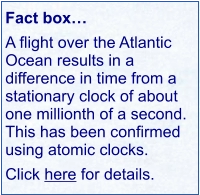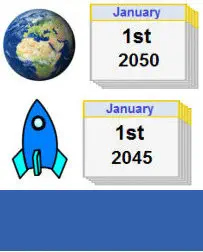
SuperFast Guide to the Twin Paradox

Advertisement

Quick and easy summaries of relativity and related subjects
The Twin Paradox is a thought experiment that originates from Albert Einstein’s
Special Theory of Relativity. It involves a pair of twins, one of whom embarks on a
journey into space at near-light speed, while the other remains on Earth. Upon the
traveling twin’s return, they find that their Earth-bound sibling has aged significantly
more.
For example, at the outset of a long space journey a pair of twins are aged 30.
However, on the return the Earth-bound twin has aged by 10 years and is therefore 40,
but due to time dilation the space-traveling twin is only 35. However, both twins would
have felt that their own time was passing normally - it would be each others clocks that
seemed to be wrong.
The paradox arises from the treatment of time in Albert Einstein’s theory of Special
Relativity. According to this theory, time runs more slowly for an object in motion
compared to an object at rest. However, each twin sees the other twin as moving, and
so each should paradoxically find the other to have aged less. This apparent
contradiction is where the paradox lies.

However, the paradox is resolved when the acceleration of the outbound twin is taken
into account. One twin has accelerated away from the other, thereby increasing their
relative velocity and so it is that twin that ages at a slower rate.
Experimental evidence for this phenomena is routinely seen in the results from particle
accelerators, such as CERN. For example, the half-life of particles (the time before a
particle decays into other particles) such as neutrons is increased in accordance with
the predictions of Special Relativity.
In conclusion, the Twin Paradox is a consequence of Special Relativity that challenges
our intuitive understanding of time. It underscores the fact that in the realm of very
high speeds our everyday experiences and intuitions may not hold true.
Suggested further reading:
Time Dilation - How time changes for anything moving
Time Dilation Calculator - How long does it take to reach the stars?

Time dilation causes a difference in observed clocks

SuperFast Guide to
The Twin Paradox
[ Special Relativity ] [ General Relativity ] [ Einstein ] [ Time Dilation ]
[ Black Holes ] [ Twin Paradox ] [ Time Dilation Formula ]
[ Special Relativity ] [ General Relativity ] [ Einstein ] [ Time Dilation ]
[ Black Holes ] [ Twin Paradox ] [ Time Dilation Formula ]
Advertisement

Quick and easy summaries of relativity and related subjects



The Twin Paradox is a thought experiment that originates from
Albert Einstein’s Special Theory of Relativity. It involves a pair of
twins, one of whom embarks on a journey into space at near-light
speed, while the other remains on Earth. Upon the traveling twin’s
return, they find that their Earth-bound sibling has aged
significantly more.
For example, at the outset of a long space journey a pair of twins
are aged 30. However, on the return the Earth-bound twin has
aged by 10 years and is therefore 40, but due to time dilation the
space-traveling twin is only 35. However, both twins would have
felt that their own time was passing normally - it would be each
others clocks that seemed to be wrong.
The paradox arises from the treatment of time in Albert Einstein’s
theory of Special Relativity. According to this theory, time runs
more slowly for an object in motion compared to an object at rest.
However, each twin sees the other twin as moving, and so each
should paradoxically find the other to have aged less. This
apparent contradiction is where the paradox lies.
SuperFast Guide to the Twin Paradox

Time dilation causes a difference in observed clocks
However, the paradox is resolved when the acceleration of the
outbound twin is taken into account. One twin has accelerated
away from the other, thereby increasing their relative velocity
and so it is that twin that ages at a slower rate.
Experimental evidence for this phenomena is routinely seen in
the results from particle accelerators, such as CERN. For
example, the half-life of particles (the time before a particle
decays into other particles) such as neutrons is increased in
accordance with the predictions of Special Relativity.
In conclusion, the Twin Paradox is a consequence of Special
Relativity that challenges our intuitive understanding of time. It
underscores the fact that in the realm of very high speeds our
everyday experiences and intuitions may not hold true.
Suggested further reading:
Time Dilation - How time changes for anything moving
Time Dilation Calculator - How long does it take to reach
the stars?
[ Special Relativity ] [ General Relativity ] [ Einstein ]
[ Time Dilation ] [ Black Holes ] [ Twin Paradox ]

[ Special Relativity ] [ General Relativity ] [ Einstein ]
[ Time Dilation ] [ Black Holes ] [ Twin Paradox ]









